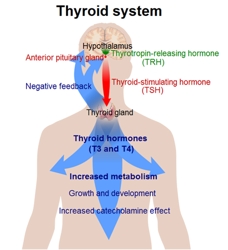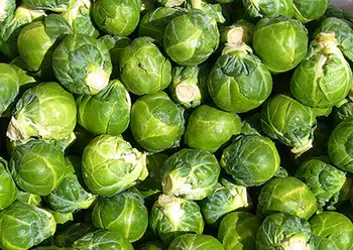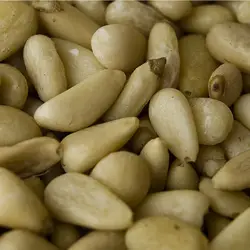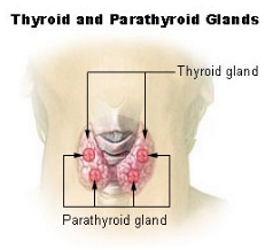|
||||||||||
 |
|
| July 08, 2013 | To ensure delivery of this email, please add newsletter@hairboutique.com to your contacts. |
Hair Loss, Thyroid Diseases and Food  This Week's Coupon, Save 20%: SUMMEROFFUN20 It’s a commonly held belief by hair loss experts that thyroid diseases can sometimes be the culprit behind thinning strands or hair loss. Sometimes when thyroid diseases are a primary catalyst of hair loss, thinning or stalled growth, it’s exacerbated by a number of foods which are categorized as goitrogens. Note: Check out – Why Do I Still Have Thyroid Symptoms? When My Lab Tests Are Normal Definition of A Goitrogen – Hair Loss Thyroid Diseases And Food A goitrogen is a substance which is known to slow the production of thyroid hormones. When the body is consistently robbed of important thyroid hormones it can activate a range of symptoms including thinning strands, hair loss, stalled hair growth, low energy, weight gain and other common issues. When the thyroid gland is bombarded with goitrogens it tries to overcompensate by producing more thyroid hormones. The result of this overworking of the gland can result in enlargement and ultimately the formation of a goiter.
A number of common foods contain goitrogens. These include foods known as cruciferous vegetables which are vegetables of the family Brassicaceae (also called Cruciferae). The family takes its alternate name (Cruciferae, New Latin for “cross-bearing”) from the shape of their flowers, whose four petals resemble a cross. Cruciferous vegetables are widely cultivated, with many genera, species, and cultivars being raised for food production such as cauliflower, cabbage, Chinese cabbage, cress, bok choy, broccoli, Broccolini, Kai-lan (Chinese broccoli), brussel sprouts, spinach, turnips and similar green leaf vegetables. Note: The Complete Idiot’s Guide to Thyroid Disease [Paperback] Goitrogens are also found in bamboo shoots, sweet potatoes, choy sum, collard greens, kale, kohlrabi, mustard greens, rapeseed (yu choy), rapini and rutabagas. Crucifer vegetables contain a substance known as isothiocyanates which are specifically tied to decreased thyroid function. Isothiocyanates may reduce thyroid function by blocking thyroid peroxidase as well as disrupting the messages sent across the membranes of thyroid cells. Isothiocyanates Isothiocyanates occur widely in nature and are studied widely in both the fields of medicine and food sciences. Foods with characteristic flavors due to isothiocyanates include wasabi, horseradish, mustard, The list of other goitrogen foods include spinach, peanuts, strawberries, millet, peaches, pears and radishes. Also included in the list are soybeans as well as all soy products including tofu and tempeh. Soy products contain isoflavones which are thought to have the same impact on the thyroid gland as isothiocyanates. Impact Of Caffeine On Thyroid Functions Some experts also believe caffeine may also cause problems to a diseased thyroid gland. Although classified amongst stimulants, caffeine suppresses normal thyroid function in some individuals. Some studies on rats suggests excess caffeine along with a deficiency in iodine may cause the growth of thyroid tumors which may or may not become cancerous. Impact Of Goitrogens On Healthy Thyroid Gland If your thyroid is healthy and your regular food intake contains appropriate levels of iodine, goitrogens in food will have little if any impact. If you have diagnosed or hidden thyroid diseases goitrogens could cause problems. Not surprisingly an impaired thyroid will be much more susceptible to the effects of goitrogens. If your thyroid is slightly impaired eating foods heavy in goitrogens could cause a condition of hypothyroidism which is also known as under-active thyroid. Many people have subtle degrees of undiagnosed hypothyroidism. Symptoms can include increased hair loss, fatigue, sadness and a range of other symptoms. Thyroid Diseases And Goitrogens
If you’ve had a test, been diagnosed with thyroid diseases and are taking thyroid medications, goitrogens may interefere with the medication. When taking medication for specific thyroid diseases be sure to talk with your health care provider about whether goitrogens should be eliminated or minimized in your nutritional plan. Most experts believe once thyroid hormones are stabilized through medications the thyroid gland will again be able to handle goitrogens. When thyroid diseases have not been medically confirmed but there’s a history of hair loss, fatigue, weight gain, sadness or even a family history of thyroid diseases you may want to voluntarily minimize the consumption of goitrogen rich foods. Impact Of Cooking On Goitrogens Foods containing isothiocyanates and isoflavones appear to be heat-sensitive. Scientists believe that as much as one third of goitrogenic substances may be deactived when cruciferous vegetables like broccoli or cauliflower are boiled in water before eating. Individuals with known or suspected thyroid issues may continue to include foods with goitrogens in their food intake if the foods are steamed or heated without incidence. It’s important to understand the impact of foods containing goitrogens if hair loss, hair thinning or stalled hair growth are a common problem. Benefits Of Cruciferous Vegetables If thyroid issues are not present, there’s no known evidence that consumption of goitrogenic foods It’s also been indicated in some studies that certain types of medications prescribed for non-thyroid related medical conditions may actually have side effects which degrade the function of thyroid hormones over time. When thyroid issues are suspected or hair loss is a concern, looking long and hard at goitrogenic foods is always wise to consider. Keep in mind that health care providers have very different opinions on the possible impact of goitrogenic foods. Summary – Hair Loss Thyroid Disease And Food Be prepared to do your own homework, alter your food intake to test results and monitor the inclusion of these foods appropriately. It’s important to note that there can be a significant difference between a balanced consumption of goitrogenic enriched foods and over-consumption. Limiting exposure to goitrogenic foods may be challenging since many popular foods included hidden ingredients which may include soy concentrates, textured vegetable proteins (TVP) and other fillers which may be unexpected. |
| If you would like to consult with Karen personally about any of your hair care questions, please see our Ask Karen page. We would love your feedback about this newsletter! Share your thoughts and ideas with us! |
 |
 |
 |
 |
 |
 |
| Copyright 1997-2009, hairboutique.com, All Rights Reserved. Terms of Service, Privacy Statement, Advertise, Contact Us, Press |
| Please note that you are receiving this mail because in the past you signed up for the HairBoutique.com mailing list. This mailing is in full compliance with U.S. Federal requirements for commercial e-mail under bill s.1618 Title 111, Section 301, Paragraph (a) (2) (c) passed by the 105th U.S. Congress. According to FTC Rules we wish to note HairBoutique.com is a member of the Amazon Affiliate Program. Any items purchased as a result of this newsletter may result in a commission being paid to HairBoutique.com |



 List Of Foods Which Contain Goitrogens – Hair Loss Thyroid Diseases And Food
List Of Foods Which Contain Goitrogens – Hair Loss Thyroid Diseases And Food caper, pine nuts and nasturtiums. These foods have different proportions of isothiocyanates which explains their different, but signature flavors.
caper, pine nuts and nasturtiums. These foods have different proportions of isothiocyanates which explains their different, but signature flavors. Experts are divided regarding the consumption of known goitrogens when there are known or suspected thyroid diseases. It is also believed that the inclusion or exclusion of goitrogens in your daily food intake should be evaluated on a case by case basis.
Experts are divided regarding the consumption of known goitrogens when there are known or suspected thyroid diseases. It is also believed that the inclusion or exclusion of goitrogens in your daily food intake should be evaluated on a case by case basis. will cause health problems. In fact, many believe cruciferous vegetables can provide a wide range of benefits including decreased risk of some types of cancerous tissues and diseases.
will cause health problems. In fact, many believe cruciferous vegetables can provide a wide range of benefits including decreased risk of some types of cancerous tissues and diseases.
